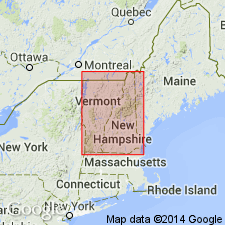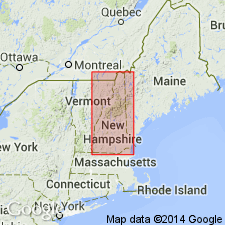
- Usage in publication:
-
- Whitefield gneiss*
- Modifications:
-
- Named
- Dominant lithology:
-
- Gneiss
- Granodiorite
- AAPG geologic province:
-
- New England province
Summary:
Included in Oliverian plutonic series. Probably named for town of Whitefield, Coos Co., northwestern NH. Consists of dark-gray, medium-grained, foliated biotite granodiorite gneiss. Age is Middle or Late Devonian(?).
Source: GNU records (USGS DDS-6; Reston GNULEX).

- Usage in publication:
-
- Whitefield Gneiss*
- Modifications:
-
- Age modified
- Geochronologic dating
- AAPG geologic province:
-
- New England province
Summary:
Used as Whitefield Gneiss of Oliverian Plutonic Suite on 1:500,000-scale derivative map of plutons and sample localities used for isotopic dating. Not separately mapped in 1:250,000-scale geologic map. Isotopic age of 458 +/-8 Ma [Middle or Late Ordovician on time scale of Palmer (1983) where 458 is boundary between Middle and Late Ordovician] determined by Zartman and Leo (1985). Age of Oliverian Plutonic Suite on 1:250,000-scale map, however, is Late Ordovician and Silurian. Age of Whitefield, therefore, is Late Ordovician.
Source: GNU records (USGS DDS-6; Reston GNULEX).
For more information, please contact Nancy Stamm, Geologic Names Committee Secretary.
Asterisk (*) indicates published by U.S. Geological Survey authors.
"No current usage" (†) implies that a name has been abandoned or has fallen into disuse. Former usage and, if known, replacement name given in parentheses ( ).
Slash (/) indicates name conflicts with nomenclatural guidelines (CSN, 1933; ACSN, 1961, 1970; NACSN, 1983, 2005, 2021). May be explained within brackets ([ ]).

